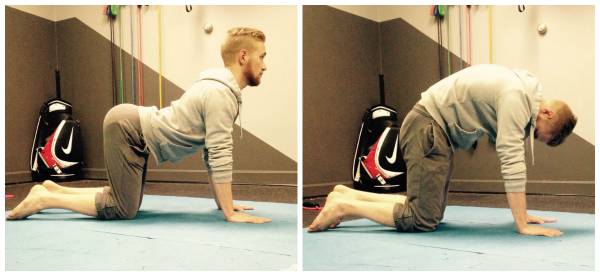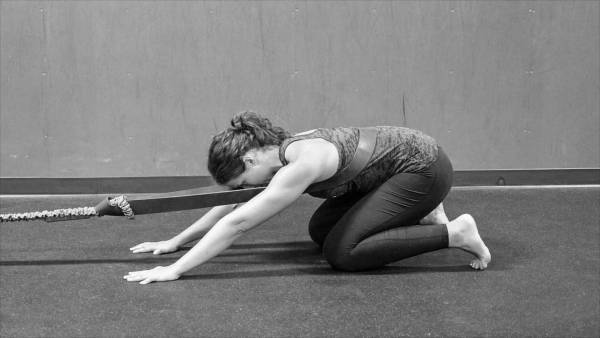If you find yourself constantly battling injuries, excess tension, and stalled progress, you may be illiterate. See, movement is a language of its own. Like any language, it has necessary building blocks and prerequisites. If you want to write a novel, you better be sure you know letters, words, and sentences. Movement is no different.
When we don’t focus on the foundation, we set ourselves up for dysfunction. As Aristotle said, “He who sees things grow from the beginning will have the finest view of them.” So let’s turn back the clock and look at human development.
Today we’ll explore two human developmental patterns that form the building blocks of your movement.
1. Spinal Movement
The spine is the axis of our movement, and it plays a huge role in organizing our bodies as they move. Every movement, from the big, sexy Olympic lifts to more basic walking and locomotion, depend on spinal integrity.1
The vertebrae act as a supple column, giving us our sense of what “vertical” means. Spinal movement is one of the earliest human developments. When these fundamental movements are compromised, we see big-time compensation later on. Repatterning spinal function has a tremendous impact not only on strength, but also on alignment and mobility.
The most fundamental spinal movement pattern is flexion and extension. Check out these exercises for a powerful reset.
- Lie on your back with knees bent (see photo below). Notice the curves of the spine here, particularly the space beneath the neck and low back.
- Begin to oscillate the low back, pressing it into the ground and arching it. As you do, tune into subtle shifts in the neck and head.
- Arch and flatten the back 12-15 times, then tune into the neutral curves of the spine. Do they feel any different?
Flexion and extension are the most fundamental spinal movements.
Now that you’ve brought some awareness to the spine and reminded the body of this foundational human movement pattern, it’s time to hone in on your control. We’ll explore the world’s slowest cat/cow stretch to do so.
- Shift yourself to hands and knees.
- Moving from tail to head, gradually arch your back, trying to slowly articulate one vertebrae at a time – think all 24 vertebrae above the sacrum. (See photo on left below.)
- When you’ve found your full arch, slowly reverse the movement one vertebrae at a time until you are curled into global spinal flexion. (See photo on right below.)
- Repeat 2 more times. See if you can control each step of the movement.

Right: Spinal extension; Left: Spinal flexion
It gets easier, I promise. But when you start out, it may be difficult to find this level of articulation. Through years of disuse we tend to forget how to control these building blocks. Remember, movement is a language, which means if we don’t use it, we lose fluency.
2. Homologous Movement
Homologous movement is how we first learn to coordinate the upper and lower halves of the body. It involves symmetrical movement of both hands or both feet.2 When thinking of homologous movements in your routine, the big three come to mind: the squat, deadlift, and press. If you want to unlock ridiculous strength in these movements, you better hone in on your building blocks.
In this case, we’ll explore rocking on hands and knees. Rocking utilizes a controlled push from both hands and both feet, forcing the halves of the body to work together. Dr. Perry Nickelston details a fantastic modification for rocking to power up the core, the resisted quadruped rock. Introducing resistance to the movement kicks our stabilizing musculature into high gear and helps us relearn this fundamental building block.

Add the resisted quadruped rock to your warm up to activate your core before performing strength exercises.
Here are Perry’s instructions for this movement:
- Use a 1.5 inch or 2 inch resistance band for optimal width and tension.
- Wrap the band around your waist and bring it up to the thoracolumbar junction T12/L1 – the bottom of the ribcage. It’s best if the band is on your skin to prevent sliding on clothing. This will also shear the fascia more effectively.
- Anchor the band low to the ground. This helps with the downward and forward pull of the band and prevents slipping.
- While in quadruped position, move back from the anchor point to establish tension.
- Your hands go below the shoulders and knees go below the hips.
- Now widen your hips for a more stable base by widening the knees.
- Bend your ankles so you are in a dorsiflexed position with toes extended.
- Keep your head in a neutral position. Do not extend or flex the neck.
- Rock backward by pushing away with your hands and sitting back into the ankles.
- Do not round your back. The band will help prevent rounding.
- Hold for 4 seconds and maintain normal breathing. If you cannot maintain normal breathing, either move closer to the anchor point to reduce tension or get a lighter band. Loss of breath control indicates the load is too high.
- Eccentrically control the return to starting position and repeat the pattern holding each concentric repetition for 4 seconds.
- Do a total of 10-12 repetitions.
Check out his article for the full scoop on the resisted quadruped rock.
Movement Is Your Alphabet
On the surface, these movements aren’t glamorous. It may feel like you’re going back to high school English. But these two developmental patterns – spinal movement and homologous movement – provide the foundation for all of our more advanced movements. When they grow foggy and fuzzy, our motor control suffers, and we miss out on huge amounts of future strength and flexibility.
Think back to language. These patterns are your alphabet. Learn them forward and backward to make consistent, injury-free progress.
References:
1. Field-Forte, EC. “Spinal Cord Control of Movement: Implications for Locomotor Rehabilitation Following Spinal Cord Injury.” Journal of American Physical Therapy Association. 80 (2000): 477-484.
2. Bainbridge Cohen, Bonnie. Sensing, Feeling, and Action: The Experimental Anatomy of Mind-Body Centering. Contact Editions, 2008.
You’ll Also Enjoy:
- The 4 Undebatable Fundamentals of Training
- Why MovNat Benefits Athletes in All Sports
- Foundation Training: Relieve Pain and Improve Performance
- New on Breaking Muscle Right Now
Photos 1 and 2 courtesy of Chandler Stevens.
Photo 3 courtesy of Perry Nickelston.






